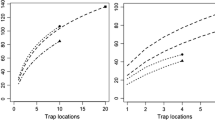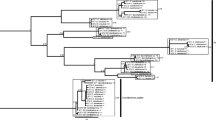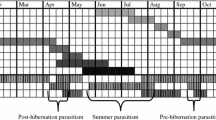Abstract
The processes underlying parasitoid community structure are little known. Stochastic niche-apportionment models provide one route to underlying assemblage rules in this and other groups. Previous work has applied this approach to parasitoids found on single host species in single populations. However, parasitoid communities are known to extend across multiple hosts and scales. The patterns of relative abundances generated by five niche-apportionment models were compared to those observed in assemblages of two sub-families of the Ichneumonidae, the Diplazontinae and Pimplinae, at landscape and patch scales, Yorkshire, UK. Three of the five models produced patterns that were significantly different to the observed pattern for all taxonomic levels at both spatial scales. The Diplazontinae fit the random fraction (RF) model at the landscape scale in broadleaved woods. This suggests that hierarchical structuring and biotic interactions may play a role in the structuring of Diplazontinae assemblages at this scale. In contrast the Pimplinae fit the RF model only at the patch scale and only at one site. However, the Pimplini tribe (all chiefly parasitoids of Lepidoptera) fit the random assortment (RA) model at both the landscape and the patch scales, whilst the Ephialtini tribe (wide range of hosts) fit no model at either scale. The ecological interpretation of the RA model suggests that the Pimplini tribe is an unsaturated assemblage, where some of the total available resources are unused. Our results show, through the fit of mechanistic niche-apportionment models, that the processes that may structure ichneumonid parasitoid assemblages are not consistent across taxa and spatial scales.




Similar content being viewed by others
References
Anderson BJ (2005) Something to do with community structure: the influence of sampling and analysis on measures of community structure. PhD thesis, University of Otago, Dunedin, New Zealand
Anderson BJ, Mouillot D (2007) Influence of scale and resolution on niche apportionment rules in saltmeadow vegetation. Aquat Biol 1:195–204
Armbruster WS (1995) The origins and detection of plant community structure: reproductive versus vegetative processes. Folia Geobot 30:483–497
Askew RR, Shaw MR (1986) Parasitoid communities: their size, structure and development. In: Waage J, Greathead D (eds) Insect parasitoids: 13th Synopsism of the Royal Entomological Society of London. Academic Press, London, pp 225–264
Bartlett R, Pickering J, Gauld I, Windsor D (1999) Estimating global biodiversity: tropical beetles and wasps send different signals. Ecol Entomol 24:118–121
Beirne BP (1941) British species of Diplazonini (Bassini Auctt.) with a study of the genital and postgenital abdominal sclerites in the male (Hym. Ichneum.). Trans R Entomol Soc Lond 91:661–712
Bonsall MB, Hassell MP (1998) Population dynamics of apparent competition in a host-parasitoid assemblage. J Anim Ecol 67:918–929
Broad GR (2005) Checklist of British and Irish Ichneumonidae (Hymenoptera). http://www.brc.ac.uk/downloads/Ichneumonidae_checklist.pdf.
Cole LR (1967) A study of the life-cycles and hosts of some Ichneumonidae attacking pupae of the green oak-leaf roller moth, Tortrix viridana (L.) (Lepidoptera: Tortricdae) in England. Trans R Entomol Soc Lond 119:267–281
Collier TR, Hunter MS (2001) Lethal interference competition in the whitefly parasitoids Eretmocerus eremicus and Encarsia sophia. Oecologia 129:147–154
Collier TR, Kelly S, Hunter M (2002) Egg size: intrinsic competition, and lethal interference in the parasitoids Encarsia pergandiella and Encarsia formosa. Biol Control 23:254–261
Dungan J, Perry JN, Dale MRT, Legendre P, Citron-Pousty S, Fortin M-J, Jakomulska A, Miriti M, Rosenburg MS (2002) A balanced view of scale is spatial statistical analysis. Ecography 25:626–640
Eijs IEM, Ellers J, van Duin G-J (1998) Feeding strategies in drosophilid parasitoids: the impact of food resources on energy reserves in females. Ecol Entomol 23:133–138
Fahy O, Gormally M (1998) A comparison of plant and carabid beetle communities in an Irish oak woodland with a nearby conifer plantation and clearfelled site. For Ecol Manage 110:263–273
Fesl C (2002) Niche-oriented species-abundance models: different approaches of their application to larval chironomid (Diptera) assemblages in a large river. J Anim Ecol 71:1085–1094
Fitton MG, Rotheray GE (1982) A key to the European genera of diplazontine ichneumon-flies with notes on the British fauna. Syst Entomol 7:311–320
Fitton MG, Shaw MR, Gauld ID (1988) Pimpline Ichneumon-flies, Hymenoptera Ichneumonidae, Pimplinae. Handbooks for the identification of British insects 7
Fraser SEM (2005) The ecology of woodland parasitoid assemblages. PhD thesis, University of York, UK
Fraser SEM, Dytham C, Mayhew PJ (2007) Determinants of parasitoid abundance and diversity in woodland habitats. J Appl Ecol 44:352–361
Fraser SEM, Dytham C, Mayhew PJ (2008a) The effectiveness and optimal use of Malaise traps for monitoring parasitoid wasps. Insect Conserv Divers 1:22–31
Fraser SEM, Dytham C, Mayhew PJ (2008b) Patterns in the abundance and distribution of ichneumonid parasitoids within and across habitat patches. Ecol Entomol 33:1–11
Fromentin JM, Dauvin JC, Ibanez F, Dewarumez JM, Elkaim B (1997) Long term variations of four macrobenthic community structures. Oceanol Acta 20:43–53
Gauld ID, Wahl DB, Broad G (2002) The suprageneric groups of the Pimplinae (Hymenoptera: Ichneumonidae): a cladistic re-evaluation and evolutionary biological study. Zool J Linn Soc 136:412–485
Holt RD (1977) Predation, apparent competition and the structure of prey communities. Theor Popul Ecol 12:197–229
Hudson P, Greenman J (1998) Competition mediated by parasites: biological and theoretical progress. Trends Ecol Evol 13:387–390
Juillet A (1959) Morphology of immature stages, life-history, and behaviour of three hymenopterous parasites of the European pine shoot moth, Rhyacionia buoliana (Schiff.) (Lepidoptera: Olethreutidae). Can Entomol 91:709–719
LaSalle J, Gauld ID (1991) Parasitic Hymenoptera and the biodiversity crisis. Redia 74:315–334
Leius K (1960) Attractiveness of different foods and flowers to the adults of some Hymenopterous parasites. Can Entomol 42:369–376
Levenson JB (1981) Woodlots as biogeographic islands in southeastern Wisconsin. In: Burgess RL, Sharpe DM (eds) Forest island dynamics in man-dominated landscapes. Springer, New York, pp 13–39
Levin S (1992) The problem of pattern and scale in ecology. Ecology 73:1943–1967
MacArthur R, Levins R (1967) The limiting similarity, convergence and divergence of coexisting species. Am Nat 101:377–385
Magurran AE (1985) The diversity of Macrolepidoptera in two contrasting woodland habitats at Banagher, Northern Ireland. Proc R Ir Acad 85b:121–132
Magurran AE (2004) Measuring biological diversity. Blackwell, Oxford
May RM (1975) Patterns of species abundance and diversity. In: Cody ML, Diamond JM (eds) The ecology and evolution of communities. Harvard University Press, Cambridge, pp 81–120
Mayhew PJ (1998) The evolution of gregariousness in parasitoid wasps. Proc R Soc Lond B 265:383–389
Mayhew PJ, Blackburn TM (1999) Does development mode organize life-history traits in the parasitoid Hymenoptera? J Anim Ecol 68:906–916
Memmott J, Godfray HCJ, Gauld ID (1994) The structure of a tropical host-parasitoid community. J Anim Ecol 63:521–540
Mouillot D, George-Nascimento M, Poulin R (2003) How parasites divide resources: a test of the niche apportionment hypothesis. J Anim Ecol 72:757–764
Müller CB, Adriaanse ICT, Belshaw R, Godfray HCJ (1999) The structure of an aphid-parasitoid community. J Anim Ecol 68:346–370
Naeem S, Hawkins BA (1994) Minimal community structure: how parasitoids divide resources. Ecology 75:79–85
Noyes JS (1989a) A study of five methods of sampling Hymenoptera (Insecta) in a tropical rainforest, with special reference to the Parasitica. J Nat Hist 23:285–298
Noyes JS (1989b) The diversity of Hymenoptera in the tropics with special reference to Parasitica in Sulewesi. Ecol Entomol 14:197–207
Owen J (1991) The ecology of a garden. Cambridge University Press, Cambridge
Owen DF, Owen J (1974) Species diversity in temperate and tropical Ichneumonidae. Nature 249:583–584
Palmer MW, White PS (1994) Scale dependence and the species-area relationship. Am Nat 144:717–740
Petit S, Usher MB (1998) Biodiversity in agricultural landscapes: the ground beetle communities of woody uncultivated habitats. Biodivers Conserv 7:1549–1561
Pianka ER (1969) Sympatry of desert lizards (Ctenotus) in Western Australia. Ecology 50:1012–1030
Pielou EC (1975) Ecological diversity. Wiley Interscience, New York
Purvis A, Hector A (2000) Getting the measure of biodiversity. Nature 405:212–219
Root RB (1967) The niche exploitation pattern of the blue–gray gnatcatcher. Ecol Monogr 37:317–350
Shaw MR (2006a) Habitat considerations for parasitic wasps (Hymenoptera). J Insect Conserv 10:117–127
Shaw MR (2006b) Notes on British Pimplinae and Poemeniinae (Hymenoptera: Ichneumonidae), with additions to the British list. Br J Ent Nat Hist 19:217–238
Sommaggio D (1999) Syrphidae: can they be used as environmental bioindicators? Agric Ecosyst Environ 74:343–356
Sperber CF, Nakayama K, Valverde MJ, Neves FD (2004) Tree species richness and density affect parasitoid diversity in cacao agroforestry. Basic Appl Ecol 5:241–251
Tokeshi M (1990) Niche apportionment or random assortment: species abundance patterns revisited. J Anim Ecol 59:1129–1146
Tokeshi M (1993) Species abundance patterns and community structure. In: Begon M, Ah Fitter (eds) Advances in ecological research vol. 24. Academic Press, London, pp 111–186
Tokeshi M (1996) Power fraction: a new explanation of relative abundance patterns in species-rich assemblages. Oikos 75:543–550
Tokeshi M (1999) Species coexistence: ecological and evolutionary perspectives. Blackwell, Oxford
Townes H (1972) A light-weight Malaise trap. Entomol News 83:239–247
van Nouhuys S, Hanski I (2000) Apparent competition between parasitoids mediated by a shared hyperparasitoid. Ecol Lett 3:81–84
Wahl DB, Gauld ID (1998) The cladistics and higher classification of the Pimpliformes (Hymenoptera: Ichneumonidae). Syst Entomol 23:265–298
Weiher E, Keddy PA (1999) Relative abundance and evenness patterns along diversity and biomass gradients. Oikos 87:355–361
Acknowledgements
We are grateful to M. Shaw (Pimplinae), G. Rotheray (Diplazontinae) and E. Diller (Diplazontinae) for help with species identification and H. Edwards and R. Shortridge for assistance with fieldwork. Thomas Hoffmeister and an anonymous referee made valuable comments on a previous version of the manuscript. We thank the many landowners for permission to establish traps in their woodlands. This work was funded by a Natural Environment Research Council studentship to S. E. M. F and UKPopNet (NERC R8-H12-01 and English Nature). This work complies with UK law.
Author information
Authors and Affiliations
Corresponding author
Additional information
Communicated by Thomas Hoffmeister.
Rights and permissions
About this article
Cite this article
Fraser, S.E.M., Dytham, C., Mayhew, P.J. et al. Community structure in ichneumonid parasitoids at different spatial scales. Oecologia 157, 521–530 (2008). https://doi.org/10.1007/s00442-008-1090-2
Received:
Accepted:
Published:
Issue Date:
DOI: https://doi.org/10.1007/s00442-008-1090-2




